-
ubuntu使用whisper和funASR-语者分离-二值化
一、选择系统
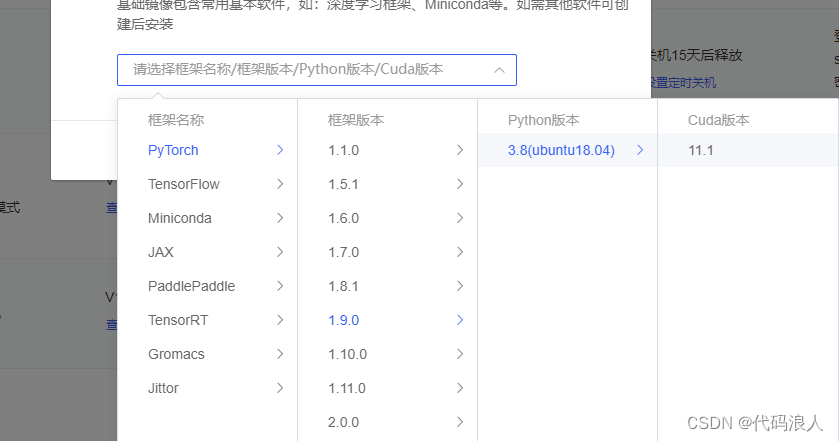

这个镜像可以

1.1 更新环境
python -m pip install --upgrade pip
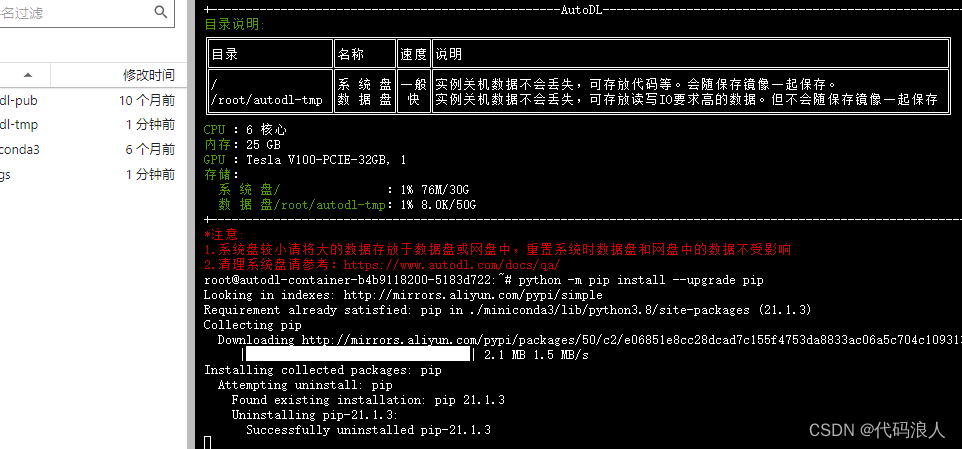
二、安装使用whisper
我在另一篇博客也写道,互相交流学习
whisper-深入-语者分离2.1 创建环境
# ssh登录系统 # 切换到root用户 mkdir /opt/tools/ cd /opt/tools/ # 安装miniconda wget https://repo.anaconda.com/miniconda/Miniconda3-latest-Linux-x86_64.sh chmod +x Miniconda3-latest-Linux-x86_64.sh ./Miniconda3-latest-Linux-x86_64.sh #按提示操作,安装目录建议选择/opt/miniconda3 #创建软链接 ln -s /opt/miniconda3/bin/conda /usr/local/bin/conda #退出shell重新登陆,然后后续操作 #创建环境 conda create -n whisper python=3.9 conda activate whisper- 1
- 2
- 3
- 4
- 5
- 6
- 7
- 8
- 9
- 10
- 11
- 12
- 13
- 14
- 15
- 16
- 17
2.1 安装
2.1.1安装基础包
pip install -U openai-whisper 或者 pip install git+https://github.com/openai/whisper.git 或者 pip install -i https://pypi.tuna.tsinghua.edu.cn/simple openai-whisper- 1
- 2
- 3
- 4
- 5
2.1.2安装依赖
pip install tiktoken pip install setuptools-rust #在conda whisper环境外执行,安装ffmpeg sudo apt update && sudo apt install ffmpeg- 1
- 2
- 3
- 4
3测试1
whisper audio.mp3 --model medium --language Chinese- 1
代码调用
import whisper import arrow # 定义模型、音频地址、录音开始时间 def excute(model_name,file_path,start_time): model = whisper.load_model(model_name) result = model.transcribe(file_path) for segment in result["segments"]: now = arrow.get(start_time) start = now.shift(seconds=segment["start"]).format("YYYY-MM-DD HH:mm:ss") end = now.shift(seconds=segment["end"]).format("YYYY-MM-DD HH:mm:ss") print("【"+start+"->" +end+"】:"+segment["text"]) if __name__ == '__main__': excute("base","1001.mp3","2022-10-24 16:23:00")- 1
- 2
- 3
- 4
- 5
- 6
- 7
- 8
- 9
- 10
- 11
- 12
- 13
- 14
- 15
- 16
3测试2 语着分离
创建key
https://huggingface.co/settings/tokens
创建代码
- cache_dir:模型啥的下载后存放位置
- use_auth_token :创建的key
import os import whisper from pyannote.audio import Pipeline from pyannote_whisper.utils import diarize_text import concurrent.futures pipeline = Pipeline.from_pretrained("pyannote/speaker-diarization", use_auth_token="你申请的key",cache_dir="/root/autodl-tmp/whisper/env") output_dir = '/root/autodl-tmp/pyannote-whisper' def process_audio(file_path): model = whisper.load_model("large") asr_result = model.transcribe(file_path, initial_prompt="语音转换") diarization_result = pipeline(file_path) final_result = diarize_text(asr_result, diarization_result) output_file = os.path.join(output_dir, os.path.basename(file_path)[:-4] + '.txt') with open(output_file, 'w') as f: for seg, spk, sent in final_result: line = f'{seg.start:.2f} {seg.end:.2f} {spk} {sent}\n' f.write(line) if not os.path.exists(output_dir): os.makedirs(output_dir) wave_dir = '/root/autodl-tmp/pyannote-whisper' # 获取当前目录下所有wav文件名 wav_files = [os.path.join(wave_dir, file) for file in os.listdir(wave_dir) if file.endswith('.wav')] # 处理每个wav文件 with concurrent.futures.ThreadPoolExecutor(max_workers=3) as executor: executor.map(process_audio, wav_files) print('处理完成!')- 1
- 2
- 3
- 4
- 5
- 6
- 7
- 8
- 9
- 10
- 11
- 12
- 13
- 14
- 15
- 16
- 17
- 18
- 19
- 20
- 21
- 22
- 23
- 24
- 25
- 26
- 27
- 28
- 29
- 30
- 31
- 32
- 33
- 34
- 35
报错ModuleNotFoundError: No module named 'pyannote'
解决方案pip install pyannote.audio- 1
报错No module named 'pyannote_whisper'如果你使用使用AutoDL平台,你可以使用
学术代理加速source /etc/network_turbo- 1
git clone https://github.com/yinruiqing/pyannote-whisper.git cd pyannote-whisper pip install -r requirements.txt- 1
- 2
- 3

这个错误可能是由于缺少或不正确安装了所需的 sndfile 库。sndfile 是一个用于处理音频文件的库,它提供了多种格式的读写支持。你可以尝试安装 sndfile 库,方法如下:
在 Ubuntu 上,使用以下命令安装:sudo apt-get install libsndfile1-dev
在 CentOS 上,使用以下命令安装:sudo yum install libsndfile-devel
在 macOS 上,使用 Homebrew 安装:brew install libsndfile
然后重新执行如上指令在项目里面写代码就可以了,或者复制代码里面的pyannote_whisper.utils模块代码
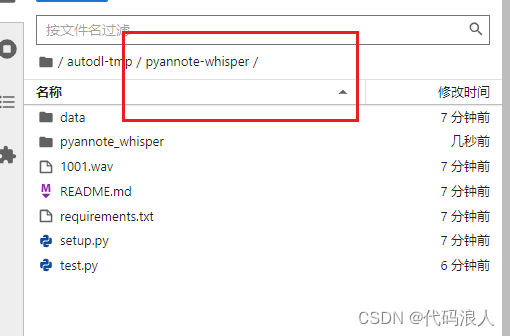
三、安装使用funASR
1 安装
1.1 安装 Conda(可选)
wget https://repo.continuum.io/miniconda/Miniconda3-latest-Linux-x86_64.sh sh Miniconda3-latest-Linux-x86_64.sh source ~/.bashrc conda create -n funasr python=3.8 conda activate funasr- 1
- 2
- 3
- 4
- 5
1.2 安装 Pytorch(版本 >= 1.11.0)
pip3 install torch torchaudio- 1
如果您的环境中存在CUDA,您应该安装与CUDA匹配的版本的pytorch。匹配列表可以在docs中找到。
1.3 安装funASR
从 pip 安装
pip3 install -U funasr # 对于中国的用户,您可以使用以下命令进行安装: # pip3 install -U funasr -i https://mirror.sjtu.edu.cn/pypi/web/simple- 1
- 2
- 3
- 4
或者从源码安装funASR
git clone https://github.com/alibaba/FunASR.git && cd FunASR pip3 install -e ./- 1
- 2
1.4 安装 modelscope(可选)
如果您想使用 ModelScope 中的预训练模型,您应该安装 modelscope:
pip3 install -U modelscope # 对于中国的用户,您可以使用以下命令进行安装: # pip3 install -U modelscope -i https://mirror.sjtu.edu.cn/pypi/web/simple- 1
- 2
- 3
1.5 如何从本地模型路径推断(可选)
通过 modelscope-sdk 将模型下载到本地目录
from modelscope.hub.snapshot_download import snapshot_download local_dir_root = "./models_from_modelscope" model_dir = snapshot_download('damo/speech_paraformer-large_asr_nat-zh-cn-16k-common-vocab8404-pytorch', cache_dir=local_dir_root)- 1
- 2
- 3
- 4
或者通过 git lfs 将模型下载到本地目录
git lfs install # git clone https://www.modelscope.cn// git clone https://www.modelscope.cn/damo/speech_paraformer-large_asr_nat-zh-cn-16k-common-vocab8404-pytorch.git.git - 1
- 2
- 3
- 4
使用本地模型路径进行推断
local_dir_root = "./models_from_modelscope/damo/speech_paraformer-large_asr_nat-zh-cn-16k-common-vocab8404-pytorch" inference_pipeline = pipeline( task=Tasks.auto_speech_recognition, model=local_dir_root, )- 1
- 2
- 3
- 4
- 5
2 使用funASR
2.1 使用funASR
from modelscope.pipelines import pipeline from modelscope.utils.constant import Tasks inference_pipeline = pipeline( task=Tasks.auto_speech_recognition, model='damo/speech_paraformer-large-vad-punc_asr_nat-zh-cn-16k-common-vocab8404-pytorch', model_revision="v1.2.4") rec_result = inference_pipeline(audio_in='1001.wav') print(rec_result['sentences']) with open('result.txt', 'w', encoding='utf-8') as f: print(rec_result, file=f) print(rec_result)- 1
- 2
- 3
- 4
- 5
- 6
- 7
- 8
- 9
- 10
- 11
- 12
- 13
- 14
- 15
- 16
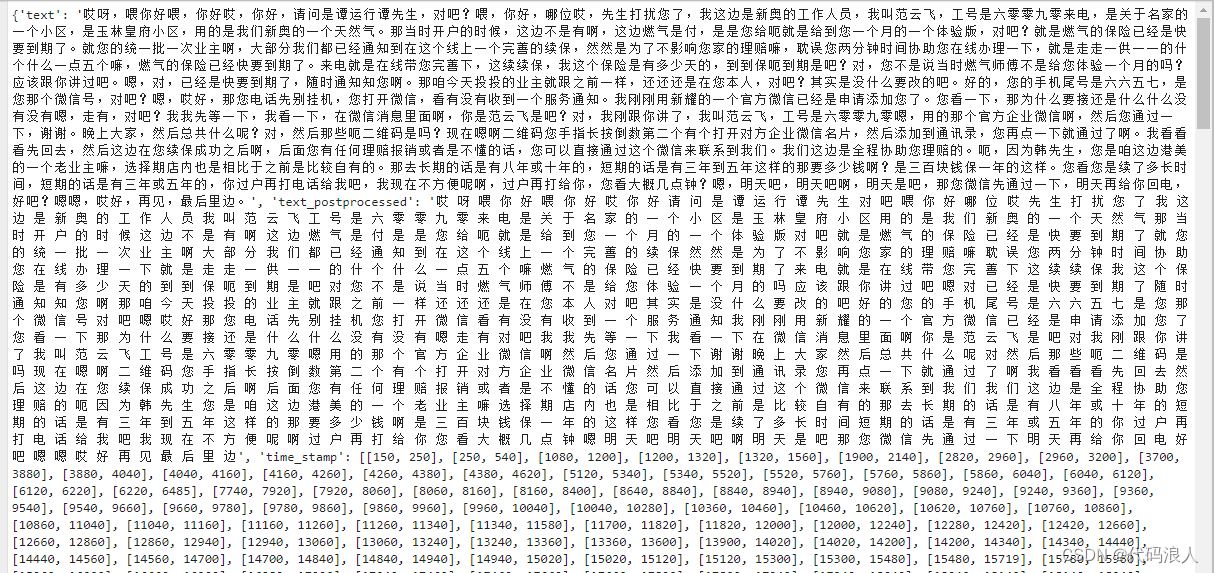
2.2 使用 pyannote.audio 进行语者分离
第一步:安装依赖
pip install pyannote.audio- 1
第二步:创建key
https://huggingface.co/settings/tokens

第三步:测试pyannote.audio
from pyannote.audio import Pipeline pipeline = Pipeline.from_pretrained("pyannote/speaker-diarization", use_auth_token="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") # send pipeline to GPU (when available) import torch pipeline.to(torch.device("cuda")) # apply pretrained pipeline diarization = pipeline("1002.wav") print(diarization) # print the result for turn, _, speaker in diarization.itertracks(yield_label=True): print(f"start={turn.start:.1f}s stop={turn.end:.1f}s speaker_{speaker}") # start=0.2s stop=1.5s speaker_0 # start=1.8s stop=3.9s speaker_1 # start=4.2s stop=5.7s speaker_0 # ...- 1
- 2
- 3
- 4
- 5
- 6
- 7
- 8
- 9
- 10
- 11
- 12
- 13
- 14
- 15
- 16
- 17
- 18
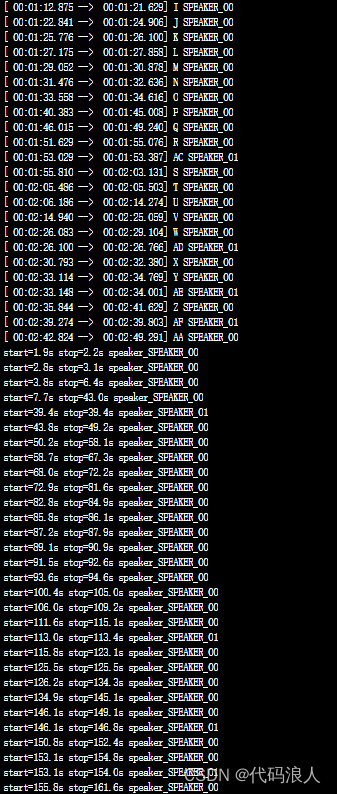
2.3 funAS整合pyannote.audio
1.1编写算法
from pyannote.core import Segment, Annotation, Timeline def get_text_with_timestamp(transcribe_res): timestamp_texts = [] for item in transcribe_res['segments']: start = item['start'] end = item['end'] text = item['text'] timestamp_texts.append((Segment(start, end), text)) print(timestamp_texts) return timestamp_texts def get_text_with_timestampFun(transcribe_res): print(transcribe_res['sentences']) timestamp_texts = [] for item in transcribe_res['sentences']: start = item['start']/1000.0 end = item['end']/1000.0 text = item['text'] timestamp_texts.append((Segment(start, end), text)) return timestamp_texts def add_speaker_info_to_text(timestamp_texts, ann): spk_text = [] for seg, text in timestamp_texts: #这行代码的作用是在给定的时间段 seg 中根据说话人分离结果 ann 获取出现次数最多的说话人。 spk = ann.crop(seg).argmax() spk_text.append((seg, spk, text)) return spk_text def merge_cache(text_cache): sentence = ''.join([item[-1] for item in text_cache]) spk = text_cache[0][1] start = text_cache[0][0].start end = text_cache[-1][0].end return Segment(start, end), spk, sentence PUNC_SENT_END = ['.', '?', '!', '。', '?', '!'] def merge_sentence(spk_text): merged_spk_text = [] pre_spk = None text_cache = [] for seg, spk, text in spk_text: if spk != pre_spk and pre_spk is not None and len(text_cache) > 0: merged_spk_text.append(merge_cache(text_cache)) text_cache = [(seg, spk, text)] pre_spk = spk elif text[-1] in PUNC_SENT_END: text_cache.append((seg, spk, text)) merged_spk_text.append(merge_cache(text_cache)) text_cache = [] pre_spk = spk else: text_cache.append((seg, spk, text)) pre_spk = spk if len(text_cache) > 0: merged_spk_text.append(merge_cache(text_cache)) return merged_spk_text def diarize_text(transcribe_res, diarization_result): timestamp_texts = get_text_with_timestampFun(transcribe_res) spk_text = add_speaker_info_to_text(timestamp_texts, diarization_result) res_processed = merge_sentence(spk_text) return res_processed def write_to_txt(spk_sent, file): with open(file, 'w') as fp: for seg, spk, sentence in spk_sent: line = f'{seg.start:.2f} {seg.end:.2f} {spk} {sentence}\n' fp.write(line)- 1
- 2
- 3
- 4
- 5
- 6
- 7
- 8
- 9
- 10
- 11
- 12
- 13
- 14
- 15
- 16
- 17
- 18
- 19
- 20
- 21
- 22
- 23
- 24
- 25
- 26
- 27
- 28
- 29
- 30
- 31
- 32
- 33
- 34
- 35
- 36
- 37
- 38
- 39
- 40
- 41
- 42
- 43
- 44
- 45
- 46
- 47
- 48
- 49
- 50
- 51
- 52
- 53
- 54
- 55
- 56
- 57
- 58
- 59
- 60
- 61
- 62
- 63
- 64
- 65
- 66
- 67
- 68
- 69
- 70
- 71
- 72
- 73
- 74
- 75
- 76
- 77
- 78
- 79
- 80
- 81
- 82
- 83
- 84
1.2调用
import os import whisper from pyannote.audio import Pipeline from pyannote_funasr.utils import diarize_text import concurrent.futures from modelscope.pipelines import pipeline from modelscope.utils.constant import Tasks # 输出位置 output_dir = '/root/autodl-tmp/pyannote-whisper' from modelscope.pipelines import pipeline from modelscope.utils.constant import Tasks # 语音转文字的模型 inference_pipeline = pipeline( task=Tasks.auto_speech_recognition, model='damo/speech_paraformer-large-vad-punc_asr_nat-zh-cn-16k-common-vocab8404-pytorch', model_revision="v1.2.4") # rec_result = inference_pipeline(audio_in='1002.wav') # with open('result.txt', 'w', encoding='utf-8') as f: # print(rec_result, file=f) # # print(rec_result) def process_audio(file_path): print("----------1") asr_result = inference_pipeline(audio_in=file_path) print("-----------2.2") # 语者分离pipeline pipeline = Pipeline.from_pretrained("pyannote/speaker-diarization", use_auth_token="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") # 使用显卡加速 import torch pipeline.to(torch.device("cuda")) #num_speakers 几个说话者,可以不带 diarization_result = pipeline(file_path, num_speakers=2) # 转文字结果 print(diarization_result) # 进行语着分离 final_result = diarize_text(asr_result, diarization_result) print("-----------5") # 输出结果 output_file = os.path.join(output_dir, os.path.basename(file_path)[:-4] + '.txt') with open(output_file, 'w') as f: for seg, spk, sent in final_result: line = f'{seg.start:.2f} {seg.end:.2f} {spk} {sent}\n' f.write(line) print(line) # 判断输出文件夹是否存在 if not os.path.exists(output_dir): os.makedirs(output_dir) wave_dir = '/root/autodl-tmp/pyannote-whisper' # 获取当前目录下所有wav文件名 wav_files = [os.path.join(wave_dir, file) for file in os.listdir(wave_dir) if file.endswith('.wav')] # 处理每个wav文件 with concurrent.futures.ThreadPoolExecutor() as executor: executor.map(process_audio, wav_files) print('处理完成!')- 1
- 2
- 3
- 4
- 5
- 6
- 7
- 8
- 9
- 10
- 11
- 12
- 13
- 14
- 15
- 16
- 17
- 18
- 19
- 20
- 21
- 22
- 23
- 24
- 25
- 26
- 27
- 28
- 29
- 30
- 31
- 32
- 33
- 34
- 35
- 36
- 37
- 38
- 39
- 40
- 41
- 42
- 43
- 44
- 45
- 46
- 47
- 48
- 49
- 50
- 51
- 52
- 53
- 54
- 55
- 56
- 57
- 58
- 59
- 60
- 61
- 62
- 63
- 64
- 65
- 66
- 67
- 68
- 69
- 70

3.微调
微调.py
import os from modelscope.metainfo import Trainers from modelscope.trainers import build_trainer from modelscope.msdatasets.audio.asr_dataset import ASRDataset def modelscope_finetune(params): if not os.path.exists(params.output_dir): os.makedirs(params.output_dir, exist_ok=True) # dataset split ["train", "validation"] ds_dict = ASRDataset.load(params.data_path, namespace='speech_asr') kwargs = dict( model=params.model, data_dir=ds_dict, dataset_type=params.dataset_type, work_dir=params.output_dir, batch_bins=params.batch_bins, max_epoch=params.max_epoch, lr=params.lr) trainer = build_trainer(Trainers.speech_asr_trainer, default_args=kwargs) trainer.train() if __name__ == '__main__': from funasr.utils.modelscope_param import modelscope_args params = modelscope_args(model="damo/speech_paraformer-large_asr_nat-zh-cn-16k-common-vocab8404-pytorch") params.output_dir = "./checkpoint" # 模型保存路径 params.data_path = "speech_asr_aishell1_trainsets" # 数据路径,可以为modelscope中已上传数据,也可以是本地数据 params.dataset_type = "small" # 小数据量设置small,若数据量大于1000小时,请使用large params.batch_bins = 2000 # batch size,如果dataset_type="small",batch_bins单位为fbank特征帧数,如果dataset_type="large",batch_bins单位为毫秒, params.max_epoch = 50 # 最大训练轮数 params.lr = 0.00005 # 设置学习率 modelscope_finetune(params)- 1
- 2
- 3
- 4
- 5
- 6
- 7
- 8
- 9
- 10
- 11
- 12
- 13
- 14
- 15
- 16
- 17
- 18
- 19
- 20
- 21
- 22
- 23
- 24
- 25
- 26
- 27
- 28
- 29
- 30
- 31
- 32
- 33
-
相关阅读:
Vilatile底层逻辑总结
【40. 石子合并(区间DP)】
解决ssh远程连接服务器出现的中文乱码问题
C++——string的封装
macOS查看切换当前用户和shell
.net 6web api注册sqlsugar全局引用
Java方法相关知识点
北美”闲鱼”Poshmark,如何销售提高成单率?附防封养号攻略
Latte:一个类似Sora的开源视频生成项目
TNet 中 JoinChannel 场景名可写可不写
- 原文地址:https://blog.csdn.net/huiguo_/article/details/133382558